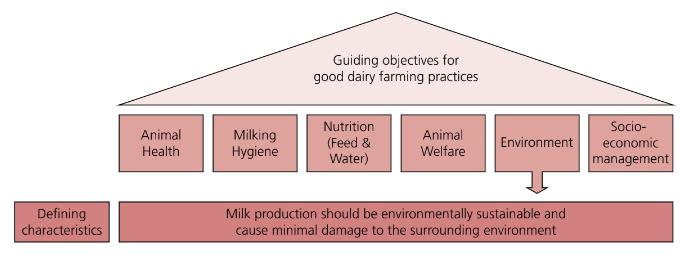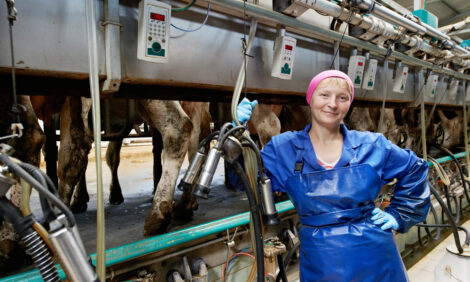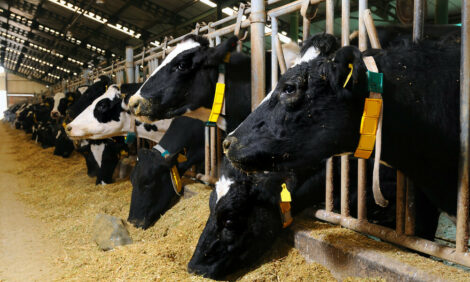



Guide to good dairy farming practice: Environment
Learn more about using natural resources efficiently and minimizing any adverse impact on the environmentPart of Series:
< Previous Article in Series Next Article in Series >
This article is from the Guide to Good Dairy Farming Practices, originally written and published by the Food and Agriculture Organization of the United Nations (FAO) and the International Dairy Federation. The Guide has been written in a practical format for dairy farmers engaged in the production of milk from any dairy species. When adopted, it will support the production and marketing of safe, quality-assured milk and dairy products. Additional sections of the Guide will be published as an article series.
Increasingly, consumers are concerned that the production of food is sustainable and is undertaken in harmony with the environment. To meet these concerns it is important that dairy farmers produce milk in a way that meets the wider community’s expectations, by using natural resources efficiently and minimizing any adverse impact on the environment.
Every dairy farmer can play a role in protecting their industry and the future of their enterprise by adopting management practices that enhance the environmental sustainability of their farming system.
The suggested good dairy farming practices for the environment are set out under the following headings:
• Implement an environmentally sustainable farming system.
• Have an appropriate waste management system.
• Ensure dairy farming practices do not have an adverse impact on the local environment.

Implement an environmentally sustainable farming system
Use farm inputs such as water and nutrients efficiently and sustainably
Some dairy farming systems rely heavily on external inputs such as irrigation water, fertiliser and feed. Dairy farmers need to consider the short and longer term impacts of using these resources on the land they farm. There may also be wider impacts on the local environment and/or community. Good dairy farming practice is aimed at improving productivity by using farm inputs efficiently and in a sustainable manner.
Minimise the production of environmental pollutants from dairy farming
Practices that manage the risks of environmental pollutants leaving the farm protect the surrounding environment and can also be good for the farm enterprise. Whilst nutrients may cause problems off the farm, they are a valuable resource on farms. The careful application of fertilisers and an effective effluent management plan will minimise off-farm impacts and can boost productivity. Greenhouse gas emissions can be more difficult to control. Practices that improve productivity such as feeding a more digestible diet and applying fertilisers appropriately can reduce methane and nitrous oxide gas emissions respectively, relative to the quantity of milk produced. Ensuring the nutrient requirements of both the plants and animals are met appropriately will help reduce/manage any potential nutrient losses.
Manage livestock to minimise adverse environmental impacts
Implement grazing and housing strategies that minimise environmental impacts. Fence off waterways and other sensitive areas from livestock.
Select and use energy resources appropriately
Dairy farmers should examine their farm’s energy consumption and consider options to reduce it. Useful energy sources can be harnessed from dairy waste streams, such as effluent and waste heat from the milk cooling system or machinery. In some circumstances, non-renewable sources of energy such as electricity and fossil fuels, can be supplemented by renewable sources such as solar, biofuels, geothermal and wind derived energy etc.
Maintain and/or encourage biodiversity15 on the farm
Although most dairy farming is undertaken in highly modified environments, there are still opportunities to encourage biodiversity. Fence off sensitive areas such as water courses to exclude livestock. Set non-productive land aside as habitat for native plants and animals. Preserve remnants of the natural ecosystem by linking non-productive areas at the local level.
Have an appropriate waste management system
Implement practices to reduce, reuse or recycle farm waste as appropriate
Implement practices to reduce waste. Re-using and/or recycling are also good dairy farming practices. Many farms can reduce their water and energy consumption by properly maintaining equipment and infrastructure, or implementing minor changes to their work routines. Opportunities to recycle plastics, drums and other consumables should also be investigated.
Manage the storage and disposal of wastes to minimize environmental impacts
Waste storage areas such as manure heaps, slurry stores and farm dumps, should be sited appropriately, considering the local amenity with regard to sight and smell, and the risk to the environment from pollution and vermin. Regularly inspect permanent slurry stores and manure heaps for signs of leaks and impending structural failure to minimize the risk of runoff polluting the environment. Ensure other wastes such as waste milk, dead livestock, plastic silage wrap, farm chemicals and fertilisers are disposed of appropriately to prevent pollution of the environment and any potential disease issues. Potential breeding sites for flies and other disease carrying vermin should be eliminated. Develop a simple waste management plan to identify when, where and at what rate to spread manures, slurry and other organic wastes to minimize the risk of causing pollution. Waste management plans should give due consideration to:
• compliance with local regulations or contractual obligations;
• avoiding possible pollution of watercourses, ponds, lakes, reservoirs, wells, boreholes, underground water from applying wastes to shallow soils and/or fissured rock;
• avoiding potential pollution of habitat areas such as woodlands, protected or recognized flora or fauna zones;
• ensuring that adequate buffer zones (non-spread areas) are maintained near vulnerable or sensitive areas such as water sources, habitat areas and the like;
• timing and level of application on sloped ground, heavy or impermeable soils and
areas subject to flooding;
• optimum application levels on areas that already have a high soil fertility;
• current or impending weather and soil conditions at the time of application, such as
frost, frozen ground, heavy rainfall and/or waterlogged soils; and
• national and regional environmental controls.
All organic manure wastes – including slurries – should be spread or incorporated into
soil when there is minimal risk to the environment.
Ensure dairy farming practices do not have an adverse impact on the local environment
Contain dairy runoff on-farm
Dairy farmers should adopt systems that avoid the potential for the contamination of the local environment. Storage facilities for oil, silage liquor, soiled water and other polluting substances must be located in a safe place and precautions must be taken to ensure that accidents do not result in the pollution of local water supplies. Avoid disposing of agricultural or veterinary chemicals where there is potential for them to enter the local environment.
Use agricultural and veterinary chemicals and fertilisers appropriately to avoid contamination of the local environment
Protect the environment by only using approved agricultural and veterinary chemicals and medicines according to the directions on the label. Ensure the safe and secure storage of farm chemicals, preferably away from the milk storage areas. Ensure the safe disposal of expired and defective chemicals and chemical containers. Consider biological and other non-chemical approaches to controlling farm pests, such as eliminating pest breeding sites. Apply integrated pest management practices where appropriate. Apply fertilisers in a manner that minimises the risks of off-site nutrient impacts. Avoid using fertilisers that contain toxins, heavy metals or other contaminants. Ensure the safe disposal or reuse of empty fertiliser bags.
Ensure the overall appearance of the dairying operation is appropriate for a facility in which high-quality food is harvested
To limit the potentially adverse impact of dairying on the landscape and to provide a positive image of dairy production, dairy farmers should ensure that access roads to their farms and the farm surroundings are clean, sheds are correctly maintained and that access roads used by dairy animals are free of effluent. Care should also be taken to ensure that the dairy operation does not impact neighbours or the local amenity by controlling dust, smells, lights, noise, flies or other nuisances.
Reference: FAO and IDF. 2011. Guide to good dairy farming practice. Animal Production and Health Guidelines. No. 8. Rome.






